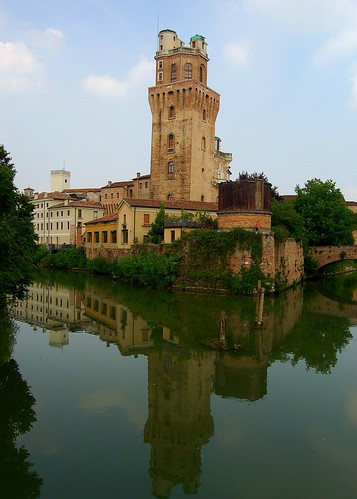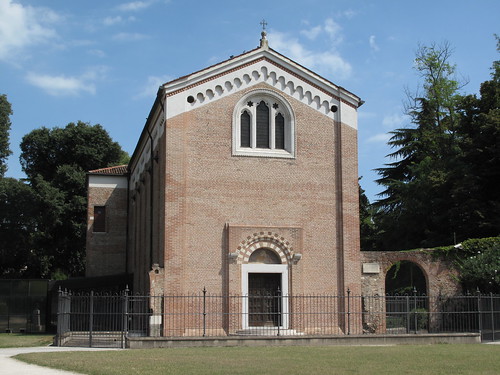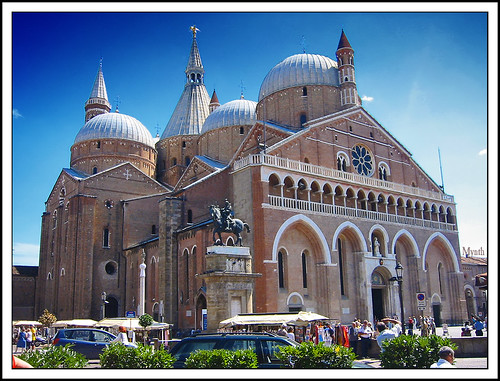
Situated only 38 kilometers from Venice, Padua is one more example in Italy of what is art in the streets. Serenity and simplicity, beauty and tranquility, are the sensations that follows this city, the land of San Antonio, where there is the famous Basilica of San Antonio, to which so many pilgrims come to seek favors or thank the Saint.
By road, we just need to access the motorway A-4 which connects Venice to Milan, but probably the most simple, cheap and quiet to do is going by train from Venice, as are excellent rail access and hourly. Legend has it that at Padua was founded by the Trojan prince Antenor after going through the Isonzo, the underground river that flows into the Adriatic by seven large fissures in the mountain. The tomb of the Trojan prince in sight of all, in a sarcophagus that is opposite the Gothic palace of Romanin.
Padua is a city rich in history. Family court was Carrara. In his University Petrarch lectured and Galileo and moreover, the most important work of Giotto is in the Scrovegni chapel in this city. But better do a tour of the city, starting from the station because the city itself, particularly its old town is easy and manageable to go. Near the station is the Chapel of the Scrovegni, the year 1303. It highlights the frescoes by Giotto, his masterpiece, his greatest work, which depicts the life of Jesus. In this truly wonderful pictorial com enjoy the panel on the «expulsion of the Moriscos» or the «Nativity» or its famous «Doomsday» painted on the west wall of the chapel. It is an inescapable visit the city because concetración ecstasy look like art in an enclosed area. It is a pleasure to look at which one can enjoy every day from 9 am to 19 pm.

Advancing via VIII Febbraio, we find an arc that take us around the main artistic core of Padua, for once crossed we arrive at the Piazza delle Erbe. There we can enjoy the Palazzo della Ragione, the medieval court of justice, and before her, next to the building, the fifteenth-century lodge, built in the thirteenth century. Go up because from there you can get good photos of the market that sits every day in this square.
Continuing straight results in what is the Piazza del Duomo. Personally, the truth is that for those coming to see the Duomo in Florence or of Milan, Padua he will leave a little perplexed to say the least, but the fact is that the Baptistery is the biggest medieval fresco cycle of Italy, painted by Giusto de Menaboi in 1378.

Leaving the Piazza del Duomo, we can enter through a beautiful bow on the side of the square and introduce by small alleys that lead us out, under the Palazzo del Capitanio, famous for its astronomical clock of the year 1344, the Piazza del Signori surrounded by arcades where there are restaurants, small shops and bars and bars to enjoy a good snack. A little later, we arrived at the Piazza della Fruta. The name says it all. It installs each day a beautiful and simple fruit market it is a pleasure to ride.
The last visit in Padua must necessarily be to the Basilica of San Antonio. When streets to get to it, nothing makes you wonder await you’ll encounter. Simply great, but immensely simple and exotic, with its Byzantine domes and many needles pointing to the sky with ferocity. Started in 1232 to hold the remains of San Antonio, and Byzantine origin, has a conical dome which rises high on seven other rounded domes. Inside the main altar has reliefs by Donatello meaning miracles of the saint. On one side of the church of St. Anthony’s tomb surprised by the hundreds or thousands of offerings that has around it shows the enthusiasm they feel for him. The walls around him are of a target that damages the eye and its reliefs were carved by great artists of the Italian Renaissance.
We could talk about other celebrity guests, like the house of Petrarch, or the Botanical Garden, one of the oldest in Europe, but nothing can match and the many feelings that we have received from this brief tour of the city, or its samples History and Art.

Padua is a haven of moderation, without the subtle beauty of Verona or the supreme nostalgia of Venice, but with a very special gift of knowledge to draw from within a calm and respect that seems to be spreading from the very bowels of the Basilica of San Antonio.
Leave a Reply
You must be logged in to post a comment.
Recent Comments